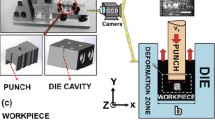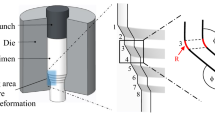Products made from wire and bars with uprated physical and mechanical characteristics are widely used in mechanical engineering. Such characteristics cannot be achieved by classical thermal and mechanical techniques. The use of new materials motivates development of new methods of hardening and achieving the required mechanical properties. Bulk nanomaterials, including those resulting from severe plastic deformation, whose mechanical properties are predetermined by ultrafine-grained structure, combine high strength, good ductility, and other properties. The purpose of severe plastic deformation is to accumulate plastic strain in the workpiece. This requires certain conditions, such as nonmonotonicity of deformation.






Similar content being viewed by others
References
R. Z. Valiev, “Creation of bulk nanostructured materials by severe plastic deformation for innovative applications in engineering and medicine,” Fis. Tekhn. Vysok. Davl., 18, No. 4, 12–20 (2008).
Ya. E. Beigel’zimer, V. N. Varyukhin, D. V. Orlov, and S. G. Synkov, Twist Extrusion: Strain Accumulation Process, TEAN, Donetsk (2003).
Ya. Beigel’zimer, A. V. Reshetov, and S. G. Synkov, “Expanding extrusion as a method of eliminating the non-uniformity of properties over the cross-section of a billet,” Fiz. Tekhn. Vysok. Davl., 16, No. 3, 108–113 (2006).
K. Abrinia and M. Makaremi, “An analytical solution for the spread extrusion of shaped sections,” Int. J. Adv. Manuf. Technol., 41, 670–676 (2009).
E. P. Unksov (ed.), W. Johnson, V. L. Kolmogorov, et al., Theory of the Plastic Deformation of Metals, Mashinostroenie, Moscow (1983).
G. A. Smirnov-Alyaev, Resistance of Materials to Plastic Deformation, Mashinostroenie, Leningrad (1978).
N. A. Chichenev, A. B. Kudrin, and P. I. Polukhin, Methods for Studying Metal-Forming Processes (experimental mechanics), Metallurgiya, Moscow (1977).
K. M. Ivanov, G. A. Danilin, P. M. Vinnik, et al., “Formation of the mechanical properties of parts during expanding extrusion,” KShP. OMD, No. 5, 3–10 (2015).
Author information
Authors and Affiliations
Corresponding author
Additional information
Translated from Metallurg, No. 3, pp. 58–63, March, 2017.
Rights and permissions
About this article
Cite this article
Vinnik, P.M., Ivanov, K.M., Danilin, G.A. et al. Studying the Deformation During Variable-Channel Direct Extrusion. Metallurgist 61, 223–229 (2017). https://doi.org/10.1007/s11015-017-0481-1
Received:
Published:
Issue Date:
DOI: https://doi.org/10.1007/s11015-017-0481-1




